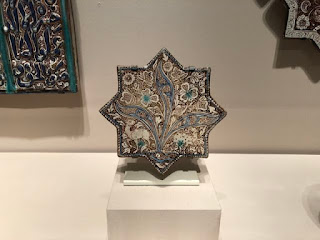Back in August 2017, my husband and I traveled to Paducah, KY. The city shared the happy coincidence of being the home of the National Quilt Museum and also being located, not only in the path of totality for a solar eclipse, but also at the point of longest totality. Perfect!
Soon after, I posted the story of the journey and the marvels of viewing a total eclipse.
And now, quite a few years later, I've completed a quilt to commemorate the magic and beauty of the eclipse.
1. A black silk velvet for the moon. One of the most stunning aspects of the eclipse was the utter blackness of the moon's disk. It was the deepest, darkest, purest black I have ever seen. I guess that's not surprising, because, after all, that side of the moon was receiving absolutely no light from the sun. I've always loved the silk velvets in Victorian era crazy quilts, because the way they absorb the deep colors popular at that time gives such rich colors. (They also are the softest and most luxurious fabrics I've ever felt.)
2. Sparkle organza for the corona. The corona was brilliant white, constantly in motion. I experimented with different ways to manipulate the fabric to mimic the shapes and depth that my eyes had seen.
3. Indigo for the sky. I'd expected a black, night sky, but it wasn't. The corona must be radiating lots of light on its own. So the sky was shades of denim blue and dusk-like. I ended up with three different indigos - one purchased online, and two dyed by friends of mine (Julie Rivera and Glennis Dolce).
I wanted the quilt to be quite simple, to convey how the sight grabbed my total attention, and was like a very odd flower floating in the sky above. At the same time, I didn't want to "just" make a portrait of the sun at totality. I wanted to add something that expressed how much those 2 minutes and 33 seconds of totality moved me.
I chose to put the sun inside a special star. It's a design that has fascinated me for a long time. I first encountered this shape in Islamic tile designs and have always intended to use it in a quilt. And here, I finally did that. Using it here represents the geometry seen in the world around us, the geometry that lets astronomers predict the exact timing of eclipses, for example.
Here are photos of the tiles that inspired me, on exhibit at the Art Institute of Chicago. The interlocking pair were made between 1250 and 1350 in Iran.
As I prepared this post, I came across this map of the campus where we watched the eclipse. Lo and behold, we were sitting just outside a building in this very star shape! I had not been thinking of that, at least not consciously, when I chose to use that star in my quilt.
I decided that I wanted more sky around the sun than I'd originally planned, but didn't have enough of any of my fabrics for the whole size that I wanted.
Eventually, after drafting help from my husband, I found a design I really liked. In fact, I liked it lots better than using a single color. I love it when things fall into place like that!
Here are the two sky fabrics basted together. It was pretty tricky because the outer, darker fabric layer is four corner triangles around a square on point of a random piece of cream fabric (because, as I said, I didn't have of a lot of any of the fabrics). The star fabric is basted onto that, and then I cut and appliquéd the star.
Then I appliquéd the corona pieces. The yellow basting thread marks out the eventual placement of the velvet moon.
I hung up the quilt, and realized that the star didn't show quite enough. I wanted it to be both "there" and "not there", since it was representing air and space. But this was a little bit too "not there".
Eventually, I came up with the idea to make pintucks to emphasize the star with shadows and no extra fabric or color. And I planned to make an echo with a second pintuck outside the appliquéd star. I made some samples from scrap fabric to see how I wanted to place the lines (upper right corner).
I used a matte cotton thread (you could use perle cotton equally well)
fed in through the needle plate and a double needle and threads on the top.
Maybe this represents a bit of pulsating solar energy. What do you think?
And finally, I basted the quilt with a piece of flannel as the center layer, and minimally quilted around the shapes. I wanted to maintain the smoothness of the sky.
I backed the quilt with the third piece of indigo, and around it, scraps from one of the fabrics used on the front. And I appliquéd my hand print that I use as a signature mark on many of my quilts. When I took this photo, I was just about to embroider the title and my name.
All these "secret" meanings make this feel like a super special quilt to commemorate this super special day.















I love your little eclipse quilt, and also the explanation of the choices behind the design and fabrics.
ReplyDeleteHi, Pat, and thanks! It was definitely fun figuring out what fabrics would give a hint of what it really looked like.
Delete